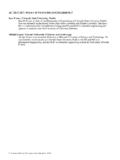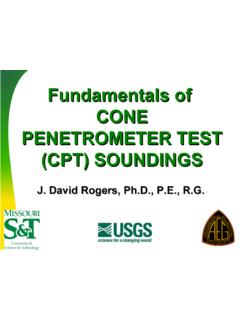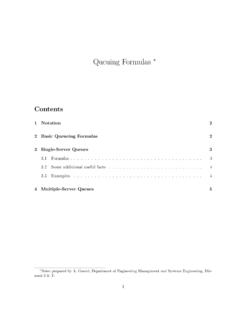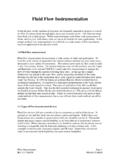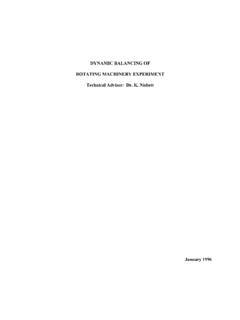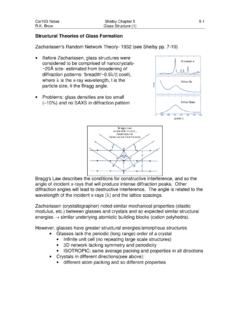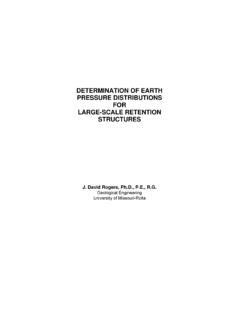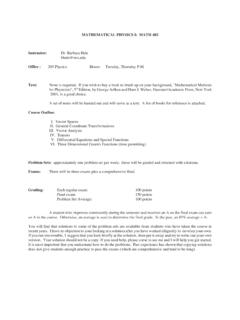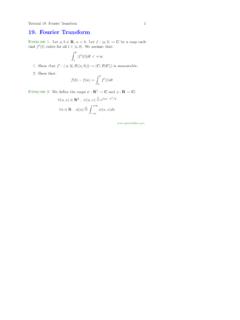Transcription of Special Functions - Missouri S&T - Missouri University of ...
1 Special Functions Leon M. Hall Professor of Mathematics University of Missouri -Rolla Copyright 1995. c by Leon M. Hall. All rights reserved. Table of Contents Chapter 1. Euler, Fourier, Bernoulli, Maclaurin, Stirling The Integral Test and Euler's Constant .. 1. Fourier Series .. 2. Bernoulli Functions and Numbers .. 4. The Euler-Maclaurin Formulas .. 6. The Stirling Formulas .. 8. Chapter 2. The Gamma Function Definition and Basic Properties .. 11. The Beta Function, Wallis' Product .. 13. The Reflection Formula .. 16. Stirling and Weierstrass .. 19. Evaluation of a Class of Infinite Products .. 21. Chapter 3. Elliptic Integrals and Elliptic Functions Motivational Examples ..23. General Definition of Elliptic Integrals..25. Evaluation of Elliptic Integrals .. 26. The Jacobian Elliptic Functions .. 29. Addition Theorems .. 30. Periodicity .. 31. Zeros, Poles, and Period Parallelograms .. 33. General Elliptic Functions ..36. Weierstrass' P-Function.
2 37. Elliptic Functions in Terms of P and P 0 .. 38. Elliptic Wheels - an Application .. 40. Miscellaneous Integrals..42. Chapter 4. Hypergeometric Functions Solutions of Linear DEs at Regular Singular Points .. 43. Equations of Fuchsian Type .. 44. The Riemann-Papperitz Equation .. 46. The Hypergeometric Equation .. 48. Confluence of Singularities .. 51. Generalized Hypergeometric Functions .. 53. Chapter 5. Orthogonal Functions Generating Functions .. 55. Orthogonality ..57. Series Expansions .. 59. i Chapter 1. Euler, Fourier, Bernoulli, Maclaurin, Stirling The Integral Test and Euler's Constant . X. Suppose we have a series uk of decreasing terms and a decreasing function f such that f (k) = uk , k=1. k = 1, 2, 3, .. Also assume f is positive, continuous for x 1, and lim f (x) = 0. x . T1. T2. T3. T n-1. 1 2 3 n-1 n n+1. Figure 1. Look at Figure 1 to convince yourself that X. n Z n uk = f (x) dx + |T1 | + |T2 | + + |Tn 1 | + un.
3 K=1 1. The left side is the sum of the areas of the rectangles on unit bases with heights u1 , u2 , .. , un determined from the left end point. |Tk | denotes the area of the triangular-shaped pieces Tk bounded by x = k + 1, y = uk , and y = f (x). Slide all the Tk s left into the rectangle with opposite vertices (0, 0) and (1, u1 ) and set An = |T1 | + |T2 | + + |Tn 1 |. Clearly (make sure it is clear), 0 < A2 < A3 < < An < u1 , so {An } is a bounded monotone sequence which has a limit: 0 < lim An = lim [|T1 | + |T2 | + + |Tn 1 |] = C u1 . n n . Let Cn = An + un . We have proved the following result, which should be somewhat familiar. Theorem (Integral Test). Let f be positive, continuous and decreasing on x 1. If f (x) 0 as x , and if f (k) = uk for each k = 1, 2, 3, .., then the sequence of constants {Cn } . n=1 defined by X. n Z n uk = f (x) dx + Cn k=1 1. converges, and 0 lim Cn = C u1 . n . Corollary (Calculus Integral Test).
4 Let f be positive, continuous and decreasing on x 1. If f (x) 0 as x , and if f (k) = uk for each k = 1, 2, 3, .., then the series . X. uk k=1. 1. converges if and only if the improper integral Z . f (x) dx 1. converges. Example (The Harmonic Series). f (x) = 1/x, uk = 1/k . By the theorem, the sequence { n }. defined by Xn Z n 1 1. = dx + n k 1 x k=1. converges, say to , where " n #. X1. = lim log n . n k k=1. The number is called Euler's constant, or the Euler-Mascheroni constant and has value = 15664 90153 28606 06512 09008 .. It is currently not known whether is even rational or not, let alone algebraic or transcendental. Exercise Use the above definition and Mathematica or Maple to find the smallest value of n for which is correct to four decimal places. Later, we will develop a better way to get accurate approximations of . Example (The Riemann Zeta Function). f (x) = 1/xs , s > 1. Now the theorem gives X. n . 1 1 1. = 1 + Cn (s).
5 Ks s 1 ns 1. k=1. where 0 < Cn (s) < 1. Let n , giving . X 1 1. = + C(s). ks s 1. k=1. with 0 < C(s) < 1. The summation is the real part of the Riemann zeta function, (s), a function with many interesting properties, most of which involve its continuation into the complex plane. However, for the real part we get that 1. (s) = + C(s), s 1. where 0 < C(s) < 1. We shall return to both these examples later. Fourier Series n o . Let L > 0 and define the Functions k (x) on [0, L] by k=1. r 2 k x k (x) = sin . L L. 2. Exercise Verify that these Functions satisfy Z L 2. k (x) dx = 1, 0. and, if j 6= k, Z L. j (x) k (x) dx = 0. 0. If these two conditions are satisfied, we call { k (x)} . k=1 an orthonormal set over [0, L]. RL R L 2. Now let f be defined on [0, L], and assume that 0 f (x) dx and 0 f (x) dx both exist. Define the Fourier coefficients of f by Z L. ak = f (x) k (x) dx. 0. We want to approximate f (x) by a linear combination of a finite subset of the above orthonormal set.
6 Exercise Show that, for any positive integer n, Z L X. n 2 Z L 2 n 2. X n X 2. f (x) ck k (x) dx = f (x) dx ak + ck ak , 0 k=1 0 k=1 k=1. and that the left side of this expression is a minimum when ck = ak , k = 1, 2, .. , n. Note that this is a least squares problem. R L Pn 2. R L 2. Pn 2. So, 0 f (x) k=1 a k k (x) dx = 0 f (x) dx k=1 ak , and, since the left side cannot be negative, n 2. X Z L 2. ak f (x) dx. k=1 0. Since this inequality is true for all n, we have Bessel's Inequality: 2. X Z L 2. ak f (x) dx. k=1 0. Notice that the important thing about the set { k (x)} was that it was an orthonormal The specific sine Functions were not the main idea. Given an orthonormal set and a function f , we call 1 ak k (x) the Fourier series of f . For our purposes, the most important orthonormal sets are those for which Z L X. n 2. lim f (x) ak k (x) dx = 0. n 0 k=1. Orthonormal sets with this property are complete. Some examples of complete orthonormal sets follow.
7 The first two are defined on [0, L] and the third one on [ L, L]. (r ) . 2 k x sin (ON 1). L L. k=1. 3. (r r r ). 1 2 x 2 2 x , cos , cos ,.. (ON 2). L L L L L. (r r r r r ). 1 1 x 1 x 1 2 x 1 2 x , cos , sin , cos , sin ,.. (ON 3). 2L L L L L L L L L. There are other complete orthonormal sets, some of which we will see later. P . For a given orthonormal set, the Fourier series k=1 ak k (x) is equal to f (x) on < x < for periodic Functions f with period 2L provided (1) f is bounded and piecewise monotone on [ L, L], f (x + h) + f (x h). (2) lim = f (x), h 0 2. (3) f is odd when (ON 1) is the orthonormal set, (4) f is even when (ON 2) is the orthonormal set. Bernoulli Functions and Numbers The Bernoulli Functions , B0 (x), B1 (x), B2 (x), .., satisfy the following conditions on < x < : B0 (x) = 1. Bn0 (x) = Bn 1 (x), n = 1, 2, 3, .. Z 1. Bn (x) dx = 0, n = 1, 2, 3, .. 0. Bn (x + 1) = Bn (x), n = 1, 2, 3, .. Exercise Show that there exist constants B0 , B1 , B2.
8 Such that for 0 < x < 1. B0. B0 (x) =. 0!0! B0 x B1. B1 (x) = +. 0!1! 1!0! B0 x2 B1 x B2. B2 (x) = + +. 0!2! 1!1! 2!0! B0 x3 B1 x2 B2 x B3. B3 (x) = + + +. 0!3! 1!2! 2!1! 3!0! etc. Exercise Show that , when n 2, Bn = n! Bn (0). Exercise Show that on (0, 1), 0!B0 (x) = B0. * Except when n = 1 or 2 and x is an integer. 4. 1!B1 (x) = B0 x + B1. 2!B2 (x) = B0 x2 + 2B1 x + B2. 3!B3 (x) = B0 x3 + 3B1 x2 + 3B2 x + B3. etc. Some authors define the Bernoulli polynomials (on ( , )) to be the right hand sides of the above equa- tions. If, in the future, you encounter Bernoulli Functions or polynomials, be sure to check what is intended by a particular author. Exercise Show that for n 2, Bn (1) = Bn (0). Exercise Compute Bn for n = 0, 1, 2, 3, .. , 12. Exercise Show that B1 (x) = x bxc 1/2 for < x < and x not an integer. [Note: bxc is the greatest integer less than or equal to x.]. Since B1 (x) = x 12 on (0, 1) and is an odd function on ( 1, 1) (do you see why?)
9 We can expand it in Fourier series using (ON 1) with L = 1. The Fourier coefficients are . Z 1 1 2 1 + ( 1)k ak = 2 (x ) sin(k x) dx = . 0 2 k 2.. Thus, ak = 0 if k is odd, and ak = k 2 if k is even. This gives . X . sin(2k x) 2 X sin(2k x). B1 (x) = 2 = . 2k 2 k k=1 k=1. Integrate term by term and use the fact that B20 (x) = B1 (x) to get . 2 X cos(2k x). B2 (x) = . (2 )2 k2. k=1. Similarly, . X. 2 sin(2k x). B2n+1 (x) = ( 1)n+1 2n+1. , (2 ) k 2n+1. k=1. and . 2 X cos(2k x). B2n (x) = ( 1)n+1 2n . (2 ) k 2n k=1. Exercise The work above with the Fourier series was done formally, without worrying about whether the results were meaningful. Prove that the formulas for B2 (x), B2n+1 (x), and B2n (x) are correct by showing that the series converge and satisfy the properties of the Bernoulli Functions . Exercise Use Mathematica or Maple to plot graphs of B1 (x), B2 (x), and B3 (x) on 0 x 4. Also graph the Fourier approximations of B1 (x), B2 (x), and B3 (x) using n = 2, n = 5, and n = 50.
10 Example (Some Values of the Riemann Zeta Function). Since Bn (0) = Bn /n!, we have B2 (0) = 1/12. Therefore, . 1 2 1 1 1. = + + + .. 12 (2 )2 12 22 32. 5. and so we get . X 1 (2 )2 2. (2) = 2. = = . k (12)(2) 6. k=1. Exercise Find (4), (6), and (8). Van der Pol used to say that those who know these formulas are mathematicians and those who do not are not. The Euler-Maclaurin Formulas Let p and q be integers and assume f is differentiable (as many times as needed) for p x q. Let k be an integer, p k < q. Then Z k+1 Z k+1 Z k+1 . f (x) dx = f (x)B0 (x) dx = lim f (x)B10 (x) dx. k k 0 k+ . Integration by parts gives Z " #. k+1 ik+1 Z k+1 . f (k) + f (k + 1). Z k+1. 0. f (x) dx = lim f (x)B1 (x) f (x)B1 (x) dx = f 0 (x)B1 (x) dx. k 0 k+ k+ 2 k Adding between p and q, we get Z q q 1 Z. X k+1 X. q Z q f (p) + f (q). f (x) dx = f (x) dx = f (k) f 0 (x)B1 (x) dx. p k 2 p k=p k=p A slight rearrangement produces the first Euler-Maclaurin Formula: X.
